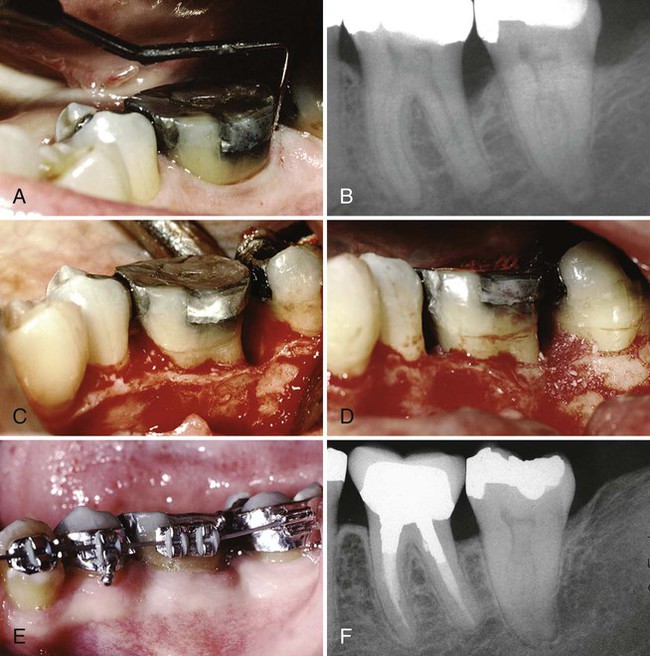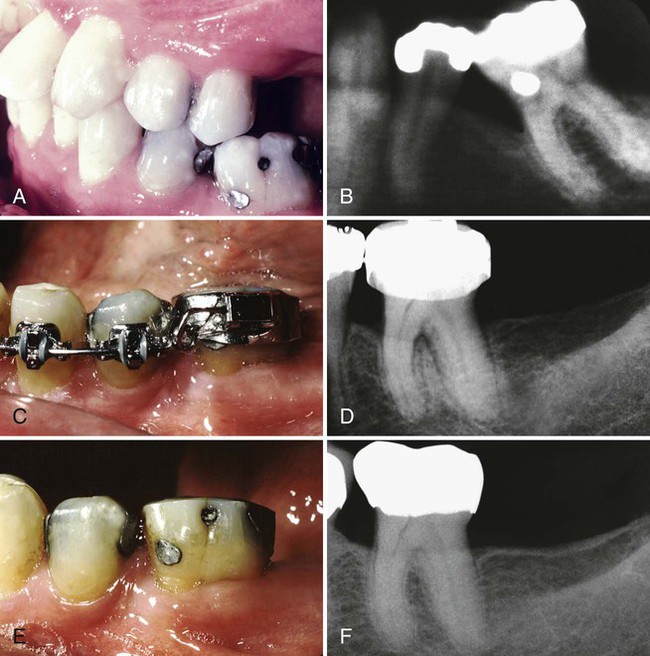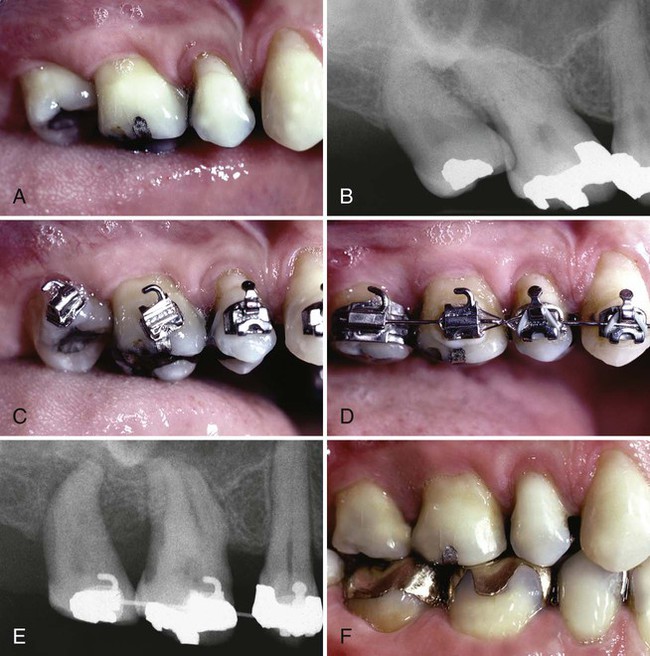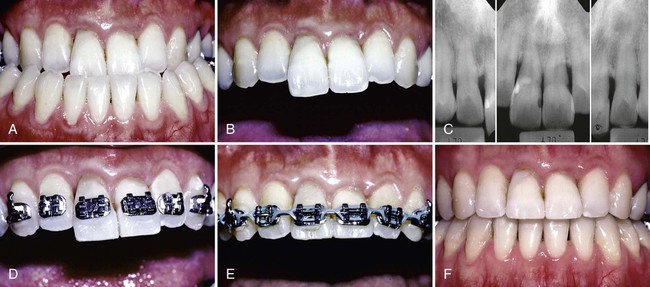Adjunctive Role of Orthodontic Therapy
Benefits of Orthodontic Therapy
1. Aligning crowded or malposed maxillary or mandibular anterior teeth permits adult patients better access to clean all surfaces of their teeth adequately. This could be a tremendous advantage for patients who are susceptible to periodontal bone loss or do not have the dexterity to maintain their oral hygiene.
2. Vertical orthodontic tooth repositioning can improve certain types of osseous defects in periodontal patients. Often, the tooth movement eliminates the need for resective osseous surgery.
3. Orthodontic treatment can improve the esthetic relationship of the maxillary gingival margin levels before restorative dentistry. Aligning the gingival margins orthodontically avoids gingival recontouring, which could require bone removal and exposure of the roots of the teeth.
4. Orthodontic therapy also benefits the patient with a severe fracture of a maxillary anterior tooth that requires forced eruption to permit adequate restoration of the root. Erupting the root allows the crown preparation to have sufficient resistance form and retention for the final restoration.
5. Orthodontic treatment allows open gingival embrasures to be corrected to regain lost papilla. If these open gingival embrasures are located in the maxillary anterior region, they can be unesthetic. In most patients, these areas can be corrected with a combination of orthodontic root movement, tooth reshaping, and restoration.
6. Orthodontic treatment could improve adjacent tooth position before implant placement or tooth replacement. This is especially true for the patient who has been missing teeth for several years and has drifting and tipping of the adjacent dentition.
Preorthodontic Osseous Surgery
Osseous Craters
An osseous crater is an interproximal, two-wall defect that does not improve with orthodontic treatment. Some shallow craters (4- to 5-mm pocket) may be maintainable nonsurgically during orthodontic treatment. However, if surgical correction is necessary, this type of osseous lesion can easily be eliminated by reshaping the defect12,15 and reducing the pocket depth (Figure 51-1) (see Chapter 60). This in turn enhances the ability to maintain these interproximal areas during orthodontic treatment. The need for surgery is based on the patient’s response to initial root planing, the patient’s periodontal resistance, the location of the defect, and the predictability of maintaining defects nonsurgically while the patient is wearing orthodontic appliances.

Three-Wall Intrabony Defects
Three-wall defects are amenable to pocket reduction with regenerative periodontal therapy.1 Bone grafts using either autogenous bone from the surgical site or allografts along with the use of resorbable membranes have been successful in filling three-wall defects.14 If the result of periodontal therapy is stable 3 to 6 months after periodontal surgery (Figure 51-2), orthodontic treatment may be initiated.

Orthodontic Treatment of Osseous Defects
Hemiseptal Defects
Hemiseptal defects are one- or two-wall osseous defects that often are found around mesially tipped teeth (Figure 51-3) or teeth that have supererupted (Figure 51-4). Usually, these defects can be eliminated with the appropriate orthodontic treatment. In the case of the tipped tooth, uprighting2,5 and eruption of the tooth levels the bony defect. If the tooth is supererupted, intrusion and leveling of the adjacent cementoenamel junctions can help level the osseous defect.


If the bone level is oriented in the same direction as the marginal ridge discrepancy, leveling the marginal ridges will level the bone. However, if the bone level is flat between adjacent teeth (see Figure 51-4) and the marginal ridges are at significantly different levels, correction of the marginal ridge discrepancy orthodontically produces a hemiseptal defect in the bone. This could cause a periodontal pocket between the two teeth.
If the bone is flat and a marginal ridge discrepancy is present, the orthodontist should not level the marginal ridges orthodontically. In these situations, it may be necessary to equilibrate the crown of the tooth (see Figure 51-4). For some patients, the latter technique may require endodontic therapy and restoration of the tooth because of the required amount of reduction of the length of the crown. This approach is acceptable if the treatment results in a more favorable bone contour between the teeth.
Some patients have a discrepancy between both the marginal ridges and the bony levels between two teeth. However, these discrepancies may not be of equal magnitude; orthodontic leveling of the bone may still leave a discrepancy in the marginal ridges (Figure 51-5). In these patients, the crowns of the teeth should not be used as a guide for completing orthodontic therapy. The bone should be leveled orthodontically, and any remaining discrepancies between the marginal ridges should be equilibrated. This method produces the best occlusal result and improves the patient’s periodontal health.

Advanced Horizontal Bone Loss
After orthodontic treatment has been planned, one of the most important factors that determine the outcome of orthodontic therapy is the location of the bands and brackets on the teeth. In a periodontally healthy individual, the position of the brackets is usually determined by the anatomy of the crowns of the teeth. Anterior brackets should be positioned relative to the incisal edges. Posterior bands or brackets are positioned relative to the marginal ridges. If the incisal edges and marginal ridges are at the correct level, the cementoenamel junction (CEJ) will also be at the same level. This relationship creates a flat, bony contour between the teeth. However, if a patient has underlying periodontal problems and significant alveolar bone loss around certain teeth, using the anatomy of the crown to determine bracket placement is not appropriate (Figure 51-6).

Many of these problems can be corrected by using the bone level as a guide to position the brackets on the teeth (see Figure 51-6). In these situations, the crowns of the teeth may require considerable equilibration. If the tooth is vital, the equilibration should be performed gradually to allow the pulp to form secondary dentin and insulate the tooth during the equilibration process. The goal of equilibration and creative bracket placement is to provide a more favorable bony architecture, as well as a more favorable crown-to-root ratio. In some of these patients, the periodontal defects that were apparent initially may not require periodontal surgery after orthodontic treatment.
Stay updated, free dental videos. Join our Telegram channel

VIDEdental - Online dental courses


